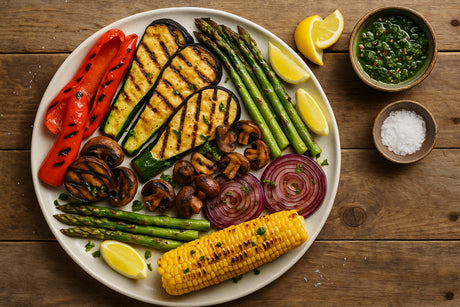Introduction
Pancetta is a traditional Italian cured meat made from pork belly. It's similar to bacon but typically cured with a mixture of salt, sugar, and spices, and it's not smoked. Making your own pancetta at home is a rewarding process that allows you to customize the flavors to your liking. Here's how to make your own pancetta. Best of all; you can make delicious Carbonara on your Arteflame with it when it's done!
Ingredients
- 3 pounds pork belly, skin removed
- 2 tablespoons kosher salt
- 1 tablespoon sugar
- 1 teaspoon pink curing salt (Prague Powder #1)
- 2 teaspoons black pepper, freshly ground
- 1 teaspoon crushed red pepper flakes
- 1 teaspoon dried thyme
- 1 teaspoon dried rosemary
- 1 teaspoon dried juniper berries, crushed
- 3 cloves garlic, minced
- 1 bay leaf, crumbled
- 1 teaspoon ground nutmeg
Instructions
Step 1: Prepare the Pork Belly
- Rinse the pork belly under cold water and pat it dry with paper towels.
- Trim any excess fat, leaving a uniform thickness of fat across the meat.
Step 2: Make the Cure
- In a small bowl, combine the kosher salt, sugar, pink curing salt, black pepper, red pepper flakes, thyme, rosemary, juniper berries, garlic, bay leaf, and nutmeg.
- Mix the ingredients well to create an even cure.
Step 3: Cure the Pork Belly
- Rub the cure mixture all over the pork belly, ensuring it is evenly coated on all sides.
- Place the pork belly in a large resealable plastic bag or wrap it tightly in plastic wrap.
- Put the wrapped pork belly in a shallow dish to catch any drips and refrigerate it for 7-10 days. Flip the pork belly and massage it every day to redistribute the cure and ensure even curing.
Step 4: Rinse and Dry
- After the curing period, remove the pork belly from the bag and rinse it thoroughly under cold water to remove the cure.
- Pat the pork belly dry with paper towels.
- Roll the pork belly tightly into a log shape and tie it with butcher's twine at 1-inch intervals.
Step 5: Hang and Dry
- Hang the rolled and tied pork belly in a cool, dry place with good air circulation. The ideal temperature is between 50-60°F (10-15°C) with a humidity level of about 60-70%.
- Let the pancetta dry for 2-3 weeks, until it feels firm but not hard.
Step 6: Slice and Enjoy
- Once the pancetta is fully dried, it is ready to be used.
- Slice the pancetta thinly and use it in your favorite recipes, such as carbonara, soups, stews, or simply enjoy it on its own.
Tips
-
Curing Salt: Pink curing salt (Prague Powder #1) is essential for safe curing and preserving the meat. It also helps maintain the pancetta's color.
-
Temperature and Humidity: Proper temperature and humidity levels are crucial for safe and effective drying. If you don't have a suitable place to hang the pancetta, a curing chamber or dedicated refrigerator can be used.
-
Spices: Feel free to customize the spice mix to your taste. Adding different herbs and spices can give your pancetta a unique flavor profile.
Variations
-
Spicy Pancetta: Increase the amount of crushed red pepper flakes or add cayenne pepper to the cure for a spicier pancetta.
-
Herbaceous Pancetta: Add fresh herbs like sage, oregano, or basil to the cure for a more herbaceous flavor.
-
Smoked Pancetta: After curing, cold smoke the pancetta for a few hours to add a smoky depth of flavor.
-
Citrus Pancetta: Add finely grated lemon or orange zest to the cure for a citrusy twist.
-
Honey-Cured Pancetta: Add a tablespoon of honey to the cure mixture for a touch of sweetness.
Best pairings
- Serve thinly sliced pancetta with fresh bread and cheese for a simple appetizer.
- Use pancetta in pasta dishes like carbonara or amatriciana.
- Wrap pancetta around vegetables or seafood for grilling.
- Add diced pancetta to soups and stews for added depth of flavor.
Conclusion
Making pancetta at home is a satisfying project that yields delicious results. With a bit of patience and attention to detail, you can enjoy homemade pancetta in a variety of dishes, adding rich, savory flavors to your meals.
